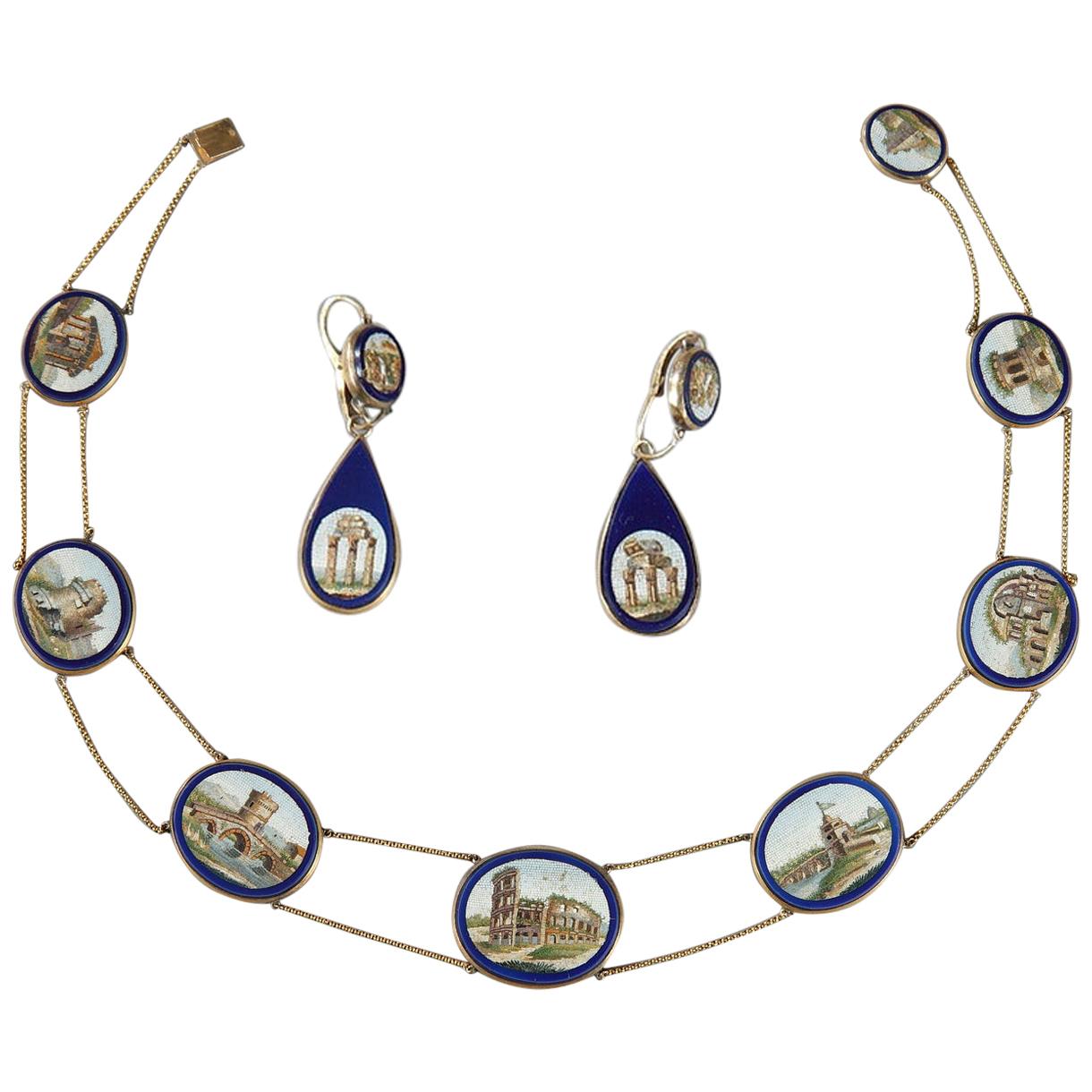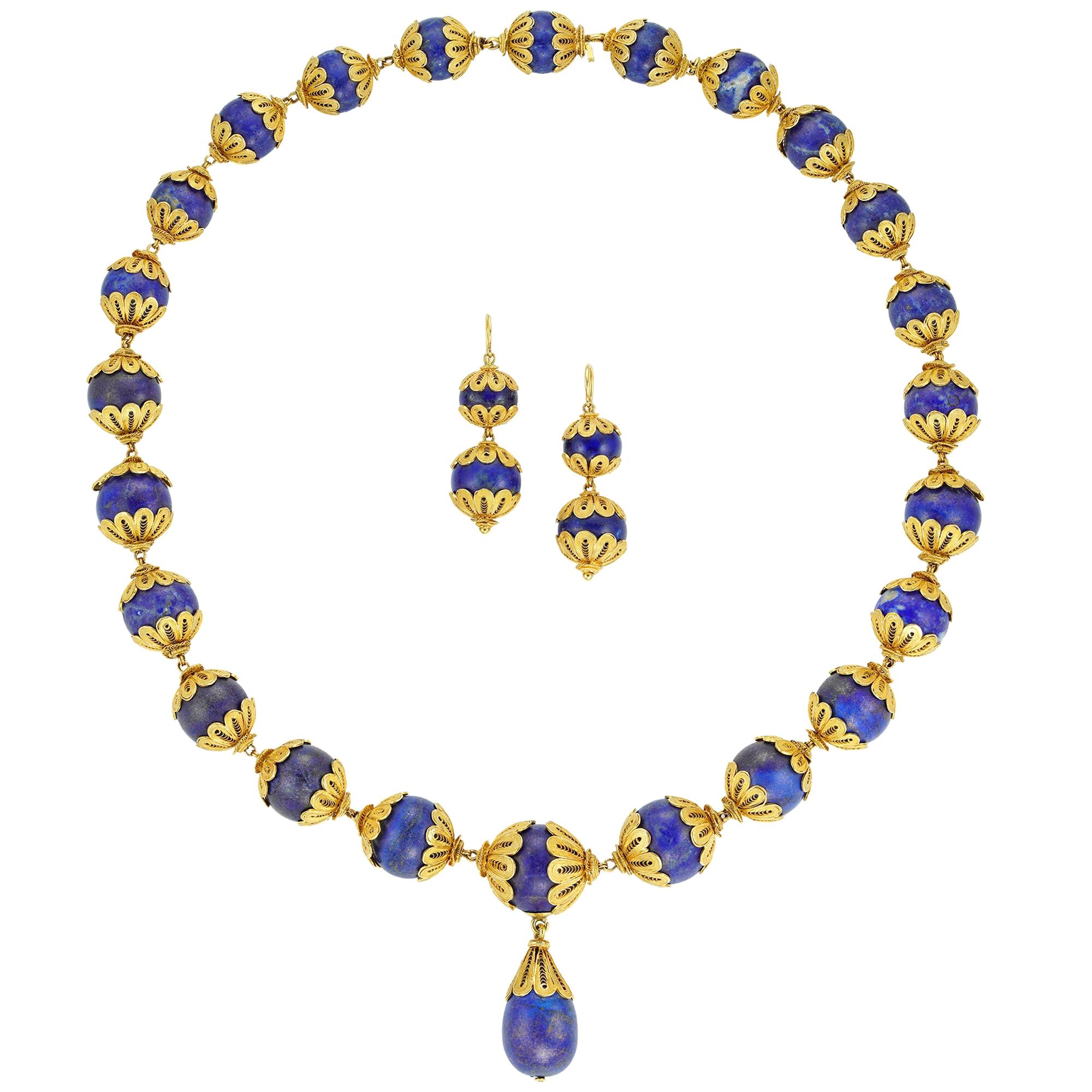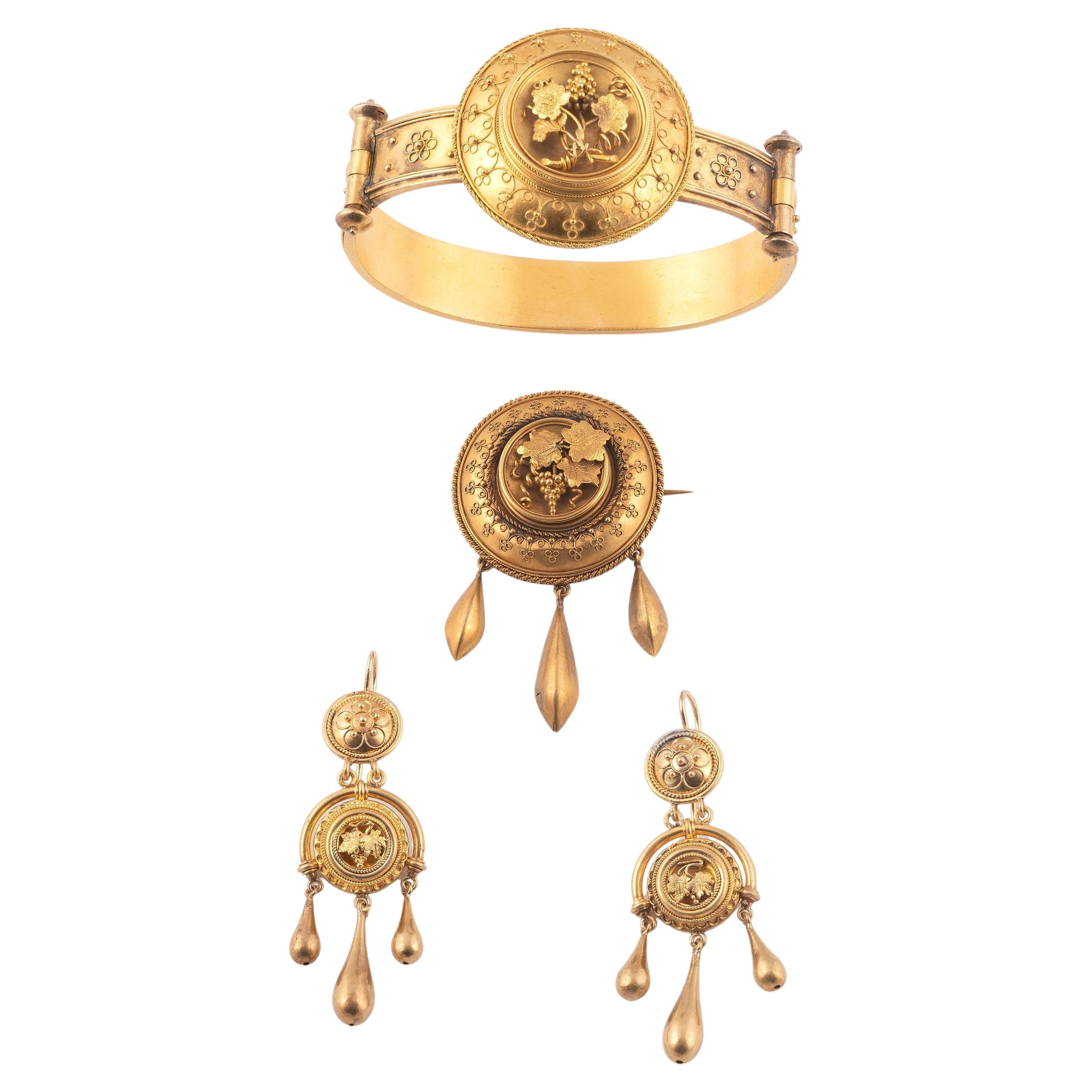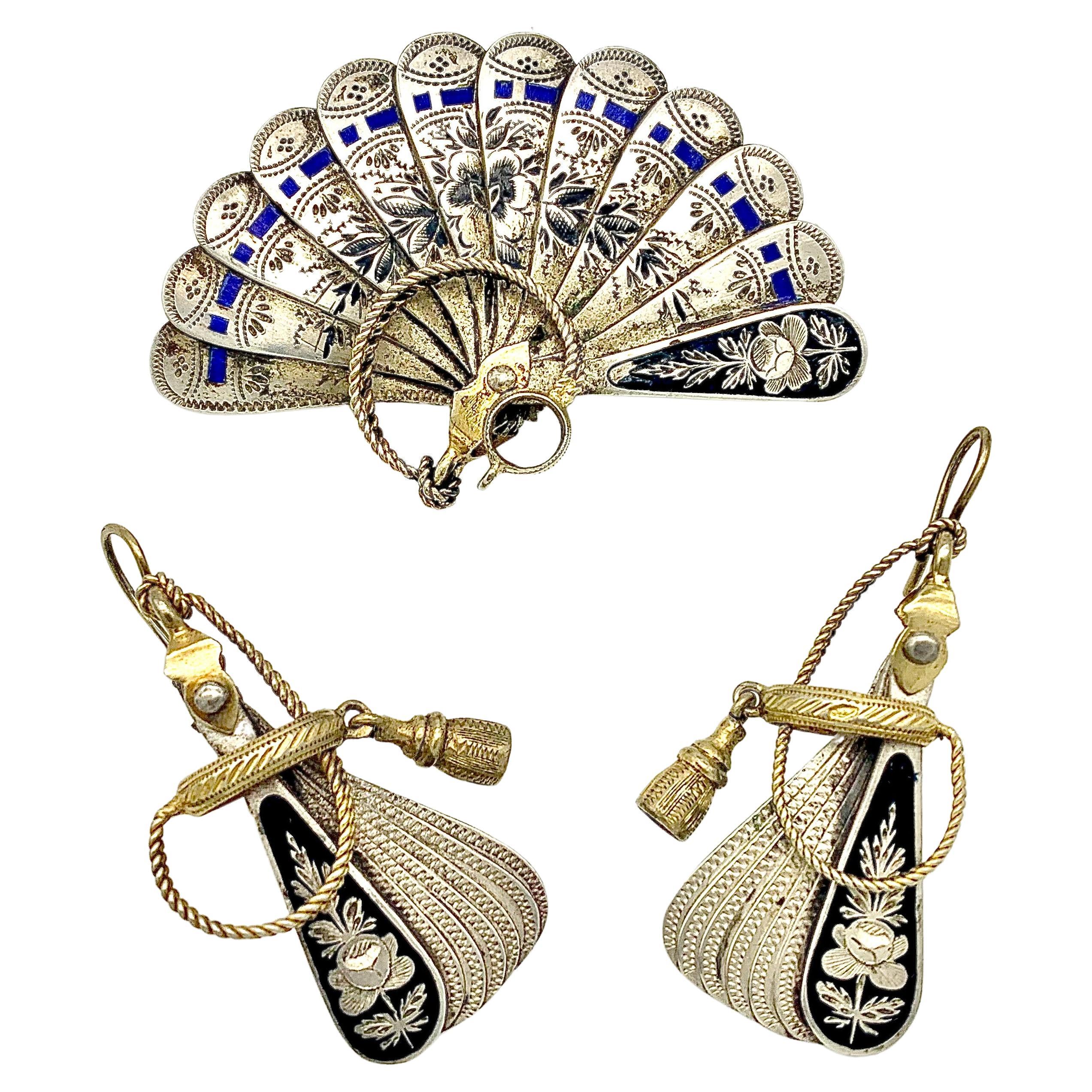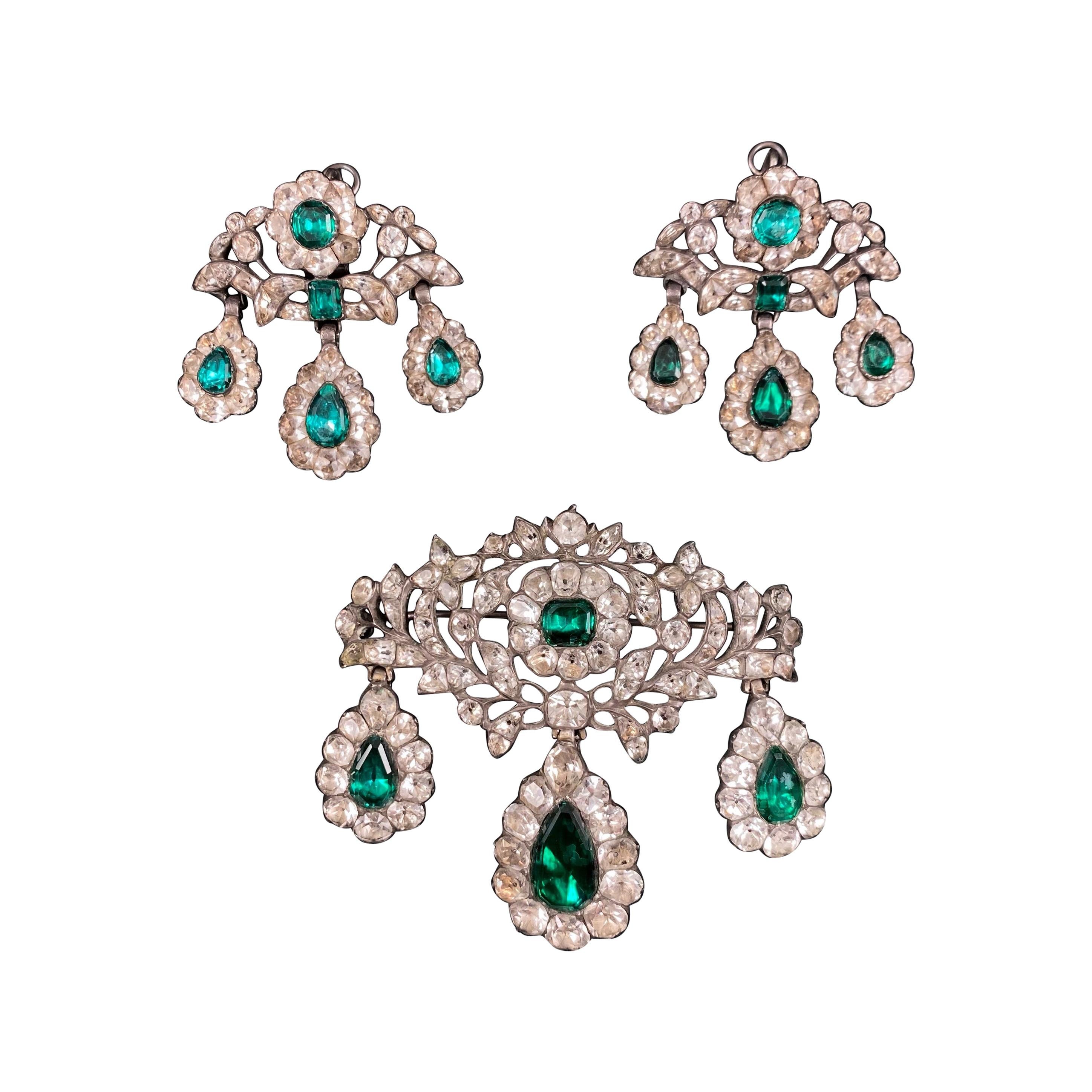Items Similar to 19th century rock crystal and carved smoky quartz demi-parure
Want more images or videos?
Request additional images or videos from the seller
1 of 9
19th century rock crystal and carved smoky quartz demi-parure
About the Item
his unusual and lovely victorian set of faceted rock crystals and carved smoky quartz was made in the second half of the 19th century.
Natural rock crystals are saluted for its way of bending the light into a “pool” of light around the wearer. They are absolutely magical and look fabulous when worn. Rock crystal is the clear transparent variety of quartz (silicon dioxide) and has a MOHS hardness rating of 7. This makes them harder than, say, opal but softer than emerald (7.5) and topaz (8). Featuring two genuine rock crystal briolettes. The beautiful briolettes are pear shaped and faceted. They sparkle beautifully. Truly special heirloom earrings to be worn and enjoyed for many years to come.
Original fitted case included.
The length of the brooch is approx. 7.5 cm.
The length of the earrings is approx 5 cm / 2 inches
All pieces are in great vintage condition. Minor wear, insignificant nicks, later hook fittings.
- Stone:
- Stone Cut:
- Dimensions:Length: 1.97 in (50 mm)
- Sold As:Set of 3
- Period:
- Date of Manufacture:1890
- Condition:Replacements made: later hook fittings. Wear consistent with age and use. All pieces are in great vintage condition. Minor wear, insignificant nicks, later hook fittings.
- Seller Location:Malmö, SE
- Reference Number:1stDibs: LU3148217481562

About the Seller
5.0
Recognized Seller
These prestigious sellers are industry leaders and represent the highest echelon for item quality and design.
Platinum Seller
These expertly vetted sellers are 1stDibs' most experienced sellers and are rated highest by our customers.
Established in 2015
1stDibs seller since 2022
31 sales on 1stDibs
Typical response time: <1 hour
- ShippingRetrieving quote...Ships From: Malmö, Sweden
- Return PolicyA return for this item may be initiated within 3 days of delivery.
More From This SellerView All
- 19th century onyx and diamond pendant earringsLocated in Malmö, SEA pair of late 19th century onyx and diamond pendant earrings. Super elegant! Each elongated onyx drop highlighted with a rose-cut di...Category
Antique Late 19th Century Drop Earrings
MaterialsDiamond, Onyx, Gold, Silver
- A 19th century diamond and zircon rose broochLocated in Malmö, SEWhen the line between want and need becomes quite blurry. A 19th century 18 karat rose brooch set with an approx. 5ct blue zircon surrounded by 269 antique, old, table and rose cut ...Category
Antique Late 19th Century European Victorian Brooches
MaterialsDiamond, Zircon, 18k Gold, Yellow Gold, Silver
- Cartier carved rock crystal “Door Knocker” earrings circa 1970By CartierLocated in Malmö, SEA pair of timeless Cartier carved rock crystal “Door Knocker” earrings - transparent yet luminous! This transparent colorless form of quartz conjures u...Category
Vintage 1970s French Modern Hoop Earrings
MaterialsCrystal, Diamond, Rock Crystal, 18k Gold, Yellow Gold
- 19th century "faith, hope and love" locket remembrance ringLocated in Malmö, SELocket ring, 18 karat gold, made late 19th century / early 20th century. Top is decorated the form of faith, hope and charity/love with a hidden compartment underneath, enamel a bi...Category
Antique 1890s European Victorian Fashion Rings
Materials18k Gold
- Early 20th century Egyptian revival gold and enamel broochLocated in Malmö, SEAn early 20th century Egyptian Revival gold brooch, depicting a vulture centred with a faïence scarab, clutching lotus pods and surmounted with a cabochon ruby, polychrome enamel decoration overall and engraved to reverse, 3.5cm wide. One arrow missing. Revival is always happening in the jewelry world. The Indiana Jones inside all of us is always enticed by the buried loot of the ancients. It’s one of the reasons Egyptian Revival jewelry is so alluring. Luckily for jewelry connoisseurs the span of history that have laid way to an aesthetic resurgence and intense interest in all things Egyptian during the last two hundred years. Napoleon’s Egyptian campaign in 1798 ignited the West’s fascination with motifs we have all come to associate with Egyptian Revival—sphinxes, pyramids, palmettes, papyrus leaves. This curiosity was further stimulated by the excitement surrounding the completion of the Suez Canal in 1869, after 10 years of construction, arousing a real revival of the Egyptian style, with jewelers specifically incorporating artifacts that were thousands of years old, faience in the shapes of falcons and scarabs, set into jewels framed by vermilion enamel and lapis lazuli. Some of the highlights in the 19th century timeline of Egyptomania include the opening of the Suez Canal in 1869, displays at World’s Fairs and the moment when Cleopatra’s Needle...Category
Early 20th Century European Egyptian Revival Brooches
MaterialsRuby, Gold, Enamel
- Antique Early 19th Century Cut-Steel NecklaceLocated in Malmö, SECut steel jewelry was at the height of fashion from the mid 1700s well into the 19th century. Originated in the 1700s. Popular from the Georgian through the Victorian eras. To make cut steel, melted horseshoe nails were formed into tiny faceted beads. Those small steel gemstone-like studs were then riveted one-by-one onto a base plate. It was an English invention that quickly travelled throughout the world. Each stud could have up to 15 facets, and in general the finer and older the piece the more facets the studs will have. Improvements in candles meant that grand events and entertaining could take place at night. As diamonds are diamonds and not available for everyone, and everyone wanted to shine, the popularity grew. Cut-steel provided a stylish and popular new jewelry material that could be enjoyed by everyone at all levels of society. It grew beyond a simple imitation to an art in its own right. The manufacturing was complex and the workmanship that was required highly skilled. These were not mass produced objects. The studs were made from decarbonated cast steel, which was case-hardened, then the studs were faceted by cutting against a pewter wheel. Next were then polished with first fine emery and a hard brush, and then by hand with a special putty. Finally they were riveted onto pierced base plates which had to be drilled and cut by hand, too. The main place of cut steel production was Birmingham, England. And there, one manufacturer stood out from all the rest: Matthew Boulton. He had been born in 1728 into the industry — his father manufactured small metal products. But the younger Boulton had a special talent for marrying the latest technology with the latest fashion. He also was continually expanding — he even founded a mint. He wined and dined with dignitaries and advocated for his steel products. Fortuitously, he became quite close with the Russian ambassador to Catherine the Great. When the ambassador toured the mint, Boulton made sure to send the Empress some of his cut-steel necklaces. In 1759, Louis XV “encouraged” the nobility to donate their gold and gemstone jewelry to help fund the Seven Years War. The popularity of cut steel in France may in part have been due to these sumptuary laws which limited who could wear precious metals and diamonds. Either you complied with the law and gave up your family jewels to be melted down for the war chest...Category
Antique Early 19th Century English Early Victorian Link Necklaces
MaterialsSteel
You May Also Like
- Micromosaic Demi-Parure Set, Early 19th CenturyLocated in Paris, FRMicromosaic demi-parure set composed of a gold necklace and earrings. The double-stranded necklace features seven oval medallions, with two smaller ovals on the drop-shaped pendant earrings. The micromosaics are set in blue glass in the medallions, and each micromosaic depicts a monument from ancient Rome. Micromosaic parure...Category
Antique 1810s French Empire Multi-Strand Necklaces
MaterialsGold
- 19th Century Lapis Lazuli Bead and Gold Demi-ParureLocated in London, GBA 19th Century lapis lazuli bead and gold demi-parure, the necklace consisted of twenty four graduated lapis beads measuring from 17.8mm to 13.6mm, with yellow gold filigree decorati...Category
Antique Mid-19th Century English Etruscan Revival Beaded Necklaces
MaterialsLapis Lazuli, Gold, 18k Gold, Yellow Gold
- Antique Demi Parure Fans Earrings and Brooch Silver Enamel Original BoxLocated in Munich, BavariaThis unusual demi parure in its original box comprises a pair of dangling earrings and a brooch in the shape of fans. The fans are made out of silver and are finely engraved with a f...Category
Antique 1880s European Dangle Earrings
MaterialsSilver, Enamel
- Hobé Demi ParureLocated in Alford, MAFabulous Hobé brooch and earrings containing unusual black marquise stones with a "drizzle" of silver overlay, each one unique. The leaf-shaped brooch contains eight of these stones,...Category
Vintage 1970s American Brooches
- Gold Archaeological Revival Parure 19th CenturyLocated in Firenze, ITComposed of a broad hinged bangle with applied grape and vine leaf, within rectangular borders, together with a pair of matching earrings, and an oval brooch with engraved detail, in...Category
Antique 1890s Italian Victorian Bangles
MaterialsGold, 18k Gold
- Antique 18th Century Minas Novas Rock Crystal Topaz Girandole Earrings BroochLocated in Lisbon, PTAntique 18th century “Minas Novas” rock crystal, colorless topaz and simulated-emerald doblet girandole earrings and pendant/brooch demi-parure, Portuguese...Category
Antique 1770s Portuguese Georgian Dangle Earrings
MaterialsCrystal, Quartz, Rock Crystal, Topaz, Silver
Recently Viewed
View AllMore Ways To Browse
Crystal Quartz Jewelry
Antique Crystal Jewelry
Antique Crystal Jewellery
Heirloom Earrings
Vintage 19th Century Jewelry
Clear Crystal Jewelry Vintage
Opal And Emerald Earring
Crystal Pear
Rock Quartz Crystal Jewlery
Carved Rock Crystal Jewelry
Carved Quartz Jewelry
Jewelry Parures
Jewellery Parure
Jewelry Parure
Antique Crystal Jewelry Set
Emerald Rock
Smoky Quartz Used For
Clear Quartz Jewelry
